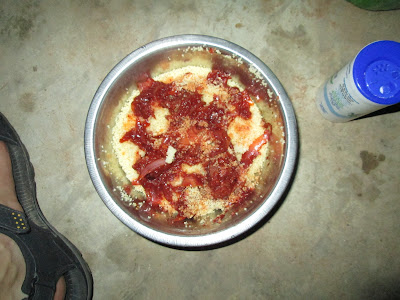Le Tö – The most consumed
food in all of Burkina. It is usually made by mashing millet or corn for
an extended period of time until it is ground into a fine grain. Then water and heat are slowly added until it
resembles a dough type substance. Tö can
be served with a wide variety of oily sauces or soups. The sauce will definitely determine the
quality of the meal because tö is relatively tasteless. Red sauce is typically made with tomatoes and
fish, beef, chicken, sheep, or goat meat.
Green sauce is made with okra or other types of leaves. Peanut sauce is made with Burkina style
peanut butter, which is basically a peanut paste without added sugar or
preservatives (tastes similar to organic peanut butter.
Riz Sauce – Another one of the
most common dishes in Burkina. Riz Sauce
(rice with sauce) is served as a bowl of white rice and a separate bowl of
sauce. Usually the choice of sauce (if
there is one) is between peanut sauce and vegetable sauce
Riz Gras- Rice cooked with tomato
paste and oil. It tastes vaguely similar
to Mexican style rice. Usually served
with meat on top.
Benga- Mixture of rice and arrico
(black eyed peas….taste similar to kidney beans). Benga is typically served with one of the
sauces described above.
Ragu d’ingyam- a broth soup made with ingyam, a legume that is very similar to a
potato
Spaghetti/Macaroni- Pasta with a
n oily tomato sauce, usually made from
palm oil and tomato paste
Kous Kous – Once in a blue moon,
my host family makes kous-kous. It
serves as a base for a variety of
sauces, but most of them are tomato
based with onions and peppers
Never eat with your left hand in
Burkina! In Africa, your left hand is
the “dirty hand” because most people use it to splash water on their under
region after using the latrine….the hole in the ground that functions as a
toilet (they don’t use toilet paper much here…). It follows that greeting someone with your
left hand is offensive. In traditional
Burkina society, left handed kids would be punished by their mothers until they
learned to do most things with their right hands.
Price Breakdown:
Weekly Peace Corps Trainee
Allowance – 10,000-12,000 CFA ($20-$24)
Our host families serve us
breakfast and dinner. Breakfast consists of coffee or tea and “gato” which is basically bread dough fried in palm oil. It’s actually really tasty when it’s served
fresh, but unless you can find the lady making it and buy it on the spot, you
usually receive it semi stale. We’re on
our own for lunch.
Riz Sauce / Riz Gras / Omelette-
300-400 CFA ($0.60-0.80)
Goat Meat Brochette – 500 CFA
($1)
Coke/Sprite/Fanta – 450 CFA
($0.90)
22oz Brakina (the equivalent of
Bud Light) – 650 CFA ($1.30)
22oz Beaufort (the equivalent of
Heineken) – 800 CFA ($1.60)
Hotel Sissilis
22oz Brakina – 850 CFA
22oz Beaufort – 1200 CFA
Hamburger – 2000 CFA
Cheeseburger – 2500 CFA
Fries – 1000 CFA
It’s important to understand that
I eat separately from the family every night, as do most PCTs, because the food
they serve me has been prepared separately from the food for the rest of the
family. Peace Corps supplies my host
family with money to pay for my meals, but the family generally cannot afford
to serve themselves the same meal. Most
nights the family eats to, riz sauce, benga, or potates/ingyams if it’s a harvest day. I never finish my meal, though, and my host
brothers and sisters finish off the rest
of my food.
We all can’t wait to be sworn in
as volunteers for a variety of reasons, one of them being the fact that our
living allowance as volunteers is WAY MORE than our living allowance as
trainees. Of course, in terms of dollars
that means about $10-$20 more per week, but to us it’s a lot!



No comments:
Post a Comment